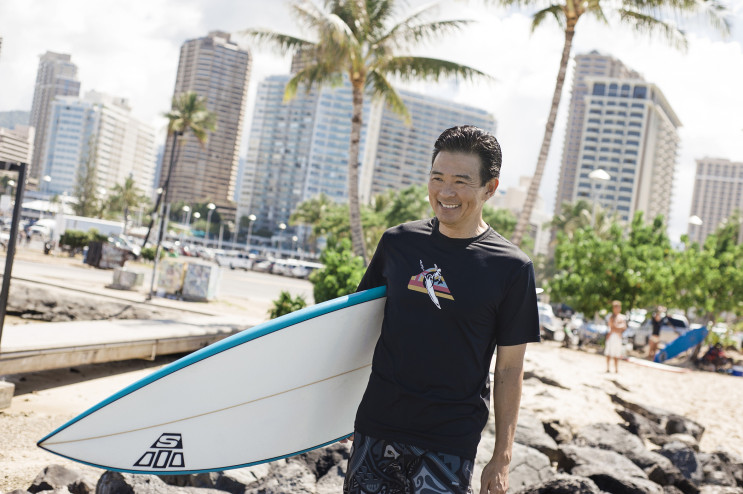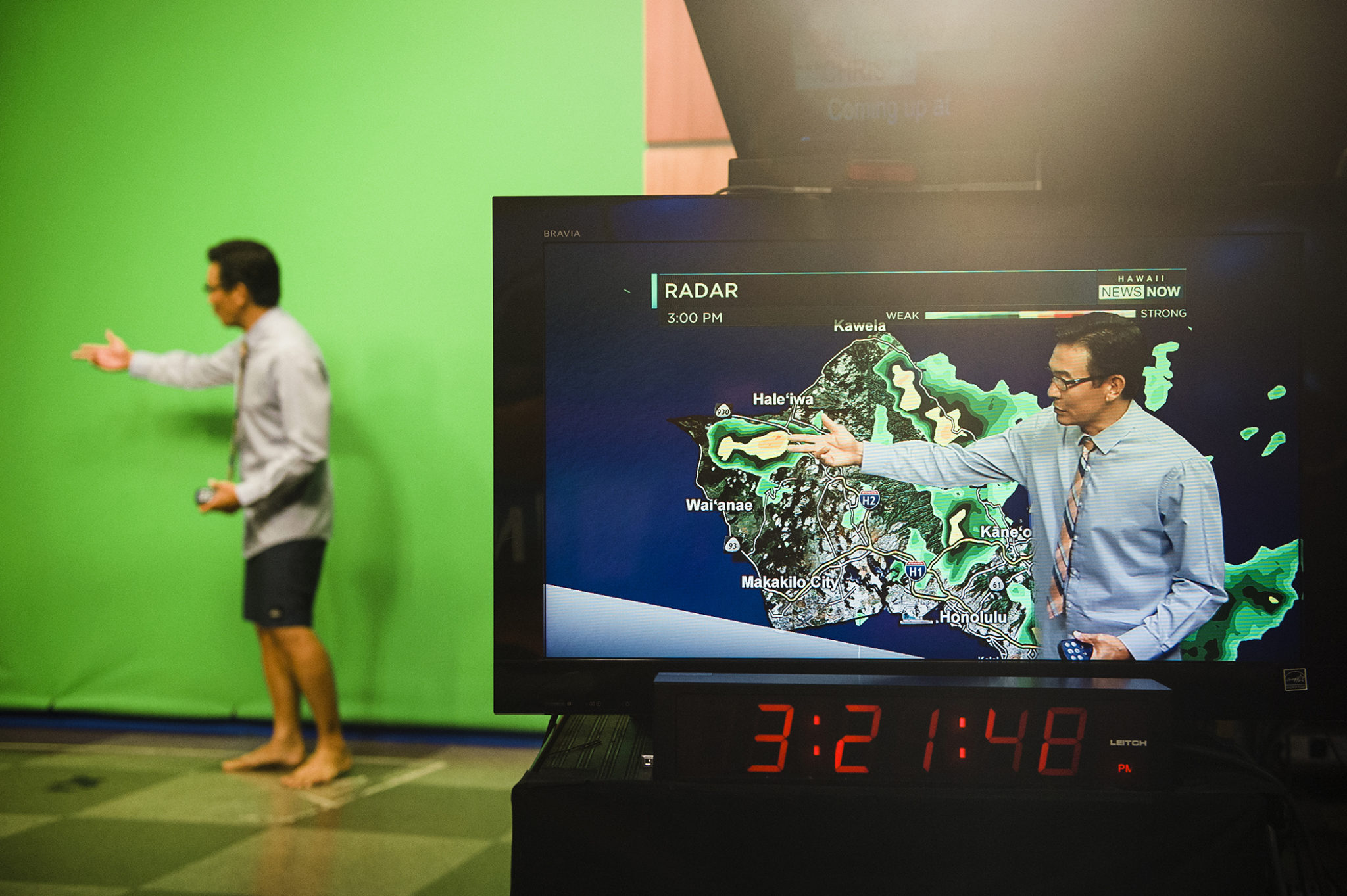Guy Hagi shares what’s it like to tell the forecast in a place with the best weather on the planet.
Twenty years ago, Guy Hagi promised himself he would never tell a lie. It was advice the young weatherman received from legendary sportscaster Jim Leahey upon the start of what would precipitate into a career as one of Hawai‘i’s most beloved weather reporters.
“The two most important things you can do is be yourself, because you cannot be anybody else,” Hagi recalls Leahey telling him, “and don’t tell a lie, because a lie will always come back and bite you in the ass.”
It’s ironic, then, that it was precisely a “lie” that made Hagi a household name—or at least a trending one—across the country as two potential hurricanes, Iselle and Julio, bowled toward the Hawaiian Islands in April 2014.
Worst Day Ever
Hagi was out of the country on a family vacation and wasn’t reporting on the movements, and yet, social media put the weatherman on blast, poking fun at Hagi for sometimes getting it wrong, as happens when trying to predict something as unpredictable as the weather.
More than 2,000 variations of memes tagged #liehagi paired previously aired screenshots of Hagi with funny captions. “You fakaz I not lying this time,” went one of the most popular. A Huffington Post article described Hagi as “having the worst day ever.”
The jovial weatherman who is known for peppering his reports with colorful commentary in the occasional Pidgin has become so top of mind that when people in Hawai‘i think about the weather, they immediately think: Guy Hagi.
And it turns out that Hagi’s persona IRL (Internet speak for “in real life”) is practically the same as his onscreen one.
“But I gotta tell you, I don’t swear nearly as much as all those memes say I do,” he jokes.
Wide-Eyed Enthusiasm
Whether he’s talking about scattered showers over Kaua‘i or a beautiful 80-degree week, Hagi gives the weather report with a wide-eyed enthusiasm. While forecasting a large swell about to hit O‘ahu’s south shore, he can seem practically giddy—which makes perfect sense upon realizing that this sport is what sparked his career as a weatherman.
At 13 years old, Hagi began making the 4-mile trek from Liliha, where he grew up, to surf at Kewalo Basin.
“The bad part is that there were no forecasts back then,” he recalls. “We walked down to the beach at the crack of dawn—flat. Or too big, one or the other.”
In high school, Hagi’s father came to the rescue when he began driving him and his two brothers down to Ala Moana Beach Park each day after school—this despite working a grueling job at the oil refinery out in Campbell Industrial Park.
“He didn’t surf,” Hagi says of his father. “He would either hit the tennis ball against the wall or walk around the park. He just was dedicated to the kids, going, ‘Eh, my kids like doing this, I going do this with them.’”
You can’t say that about every story in the news, but everything in weather applies to every single person.


Early Start
After graduating from McKinley High School in 1978, Hagi began working as a sales clerk at Town and Country Surf. A few months later, local radio stations looking, perhaps, to capitalize on the booming surf industry, wanted to run surf reports on air, and Hagi was tapped for the job—mostly, he says, because he was the only one willing to wake up early enough to call in the report at 7 o’clock in the morning.
“It was very rudimentary at the time,” recalls Hagi, who was one of two guys giving reports. “I had observers around all points of the island, and I’d call ’em up at 6:30 a.m., compile a report, and then do an update at noon.” Even after he left Town and Country in 1982 for a sales position with ocean sports company Water Bound, Hagi continued calling in his reports—in total, he was the radio voice of surf for nearly 20 years. Listeners tuned in to KKUA and KQMQ would hear, on the hour, “This is Guy Hagi with the Town and Country surf report.”
When a weather reporter position opened up at KITV in 1994, the name that came up was one they’d heard on the radio for all those years—Guy Hagi.
Star Quality
While he wasn’t a standard candidate, lacking TV experience as well as a degree in meteorology or journalism, Hagi’s star quality was on the rise amongst the local surf community. He had also been studying weather patterns for years to expand his surf reports.
Hagi accepted the job at KITV and began diligently preparing for the position, reading Weather in Hawaiian Waters by then-state climatologist Paul Haraguchi and following forecast discussions from the National Weather Service.
After a couple months of preparation and before he could go on air, Dan Cooke at KHNL approached him to cover the weather for a new two-hour morning alongside anchor Lee Cataluna. He bit.
“It was good because nobody was watching,” he says. “I had two hours of practice every day.”
Seven years later, in 2001, Hagi moved to KGMB (today called Hawaii News Now, a shared service between KHNL, KFVE, and KGMB), where he has served as the resident weatherman ever since.
Today, before he checks in at the newsroom at 2 p.m., Hagi takes care of domestic duties like prepping dinner, which he does nearly five days a week, or taking his daughter’s cracked iPhone screen to get fixed.
Like Father Like Son
His family is comprised of his wife Kim Gennaula, the veteran journalist who anchored KGMB’s weeknight spots for 15 years before becoming the executive director of advancement at ‘Iolani School, and their two children Alia, 11, and Luke, 12.
Like his father, Hagi emphasizes the importance of spending time with his family, returning home to Kaimukī five days a week after his afternoon news brief to sit down for dinner with Gennaula and the kids, then returning to the station at 8 p.m. to prepare for the taping of the evening news.
In the newsroom, which is in Kalihi, Hagi’s station is walled off from the rest of the 100-person news staff, who have huddled open cubicles. It isn’t by design, but Hagi is grateful for the physical barrier, a symbolic extension of the personal separation he puts between himself and the news desk.
Ask Hagi what the day’s top story is, and he can’t tell you.
“Maybe it’s a defense mechanism I put up,” says Hagi, who gives his weather briefing to the rest of the news team, then leaves without hearing what else will air that night. It’s an outlook shaped in part by an instance in 1999, when the story on the mass shooting at Xerox broke. Hagi, who was doing weather, was the only other reporter alongside anchor Lyle Galdeira on the desk during KHNL’s morning show.
“Lyle grabbed a cameraman and went chasing the story, which was evolving throughout the morning,” Hagi recalls. “It’s just me and Lyle, so I gotta go on the desk and report what Lyle’s telling me and inform the public of what’s going on.”
The experience dampened Hagi’s upbeat spirit and stuck with him for a long time afterward. “News people get calloused by [the news], shaped by it, and it changes your outlook on everything,” he says.
Today, the running joke at the newsroom is a lineup that frequently follows: death, murder, Hagi. “We’re going to dig this hole, and Guy, you gotta bring us out,” he says of what his news colleagues like Stephanie Lum or Keahi Tucker might say. “Because nine times out of ten, what am I talking about? Best weather on the planet.”
A hurricane is like a zombie. If you get killed by a zombie, that’s your fault—the thing is walking two feet every second. A hurricane is the same way.


Zombie Weather
The 10 percent of bad weather that does come is often in the form of tsunamis or hurricanes. News being what it is, Hagi acknowledges that some sensationalism may go into coverage of extreme weather conditions. For his part, Hagi plays down the severity until the National Weather Service tells him otherwise.
“A hurricane is like a zombie. If you get killed by a zombie, that’s your fault—the thing is walking two feet every second. A hurricane is the same way. We got a forecast tracker five days out, and that forecast track adjusts as it gets closer.”
The National Weather Service, which Hagi uses exclusively to prepare his forecasts, is able to track large storms and swells with relative accuracy—when they’ll hit and how strong they’ll be—but the smaller showers and wave conditions are harder to predict. Hagi keeps tabs on how many times they get weather predictions right, which he estimates is about 75 percent.
Taking the Blame
But no one remembers when someone is right, and as the proverbial messenger of the National Weather Service, Hagi is the one who gets killed when forecasts go south—he hears about it everywhere, from the grocery store checkout line when he’s buying bread (“You know, it rained, and you said it wasn’t going rain!” says Hagi in a screechy voice while scrunching his nose) to, of course, online.
Despite his attempts to stay shielded from deflating news, Hagi says it is becoming harder to do. “Remember that show in the ’50s, Happy Days … where the kids would do all kine crazy stuff like eating goldfish?” Hagi asks contemplatively.
“One of the stunts they used to do was to try and pack the most amount of kids into a car. But no matter how they squirmed around, there’d be a finite amount of kids that can fit into the car. This island is akin to that. We’re getting to the point where we’re putting too many people on this island, too many cars, too many houses, too many roads … the burgeoning growth of this place scares me.”
Value of Weather
With all the changes Hawai‘i is facing, then, it feels safe to take jabs at the one constant: the weather.
“The value of the weather in the newscast is it affects everybody,” Hagi says. “You can’t say that about every story in the news, but everything in weather applies to every single person.”
So when Hagi gets it wrong, it’s easy to blame him, to string him up for bringing rains to our weddings or tropical storms to our first birthday luaus, as if he is some mythic being, a conjurer of storms and passing showers.
But, Hagi explains, “The nature of weather and the science of forecasting is such that it’s impossible to get a forecast right 100 percent of the time, because we’re talking about a living, breathing thing that changes, and every subtle change will affect the outcome.”
He likens predicting the weather to forecasting a football game. Can the football forecaster ever pinpoint the game’s final score? Probably not.
“But today,” says Hagi, looking up to clear, blue skies, “we hit the nail on the head.”
This story was featured in our Charm Issue.



